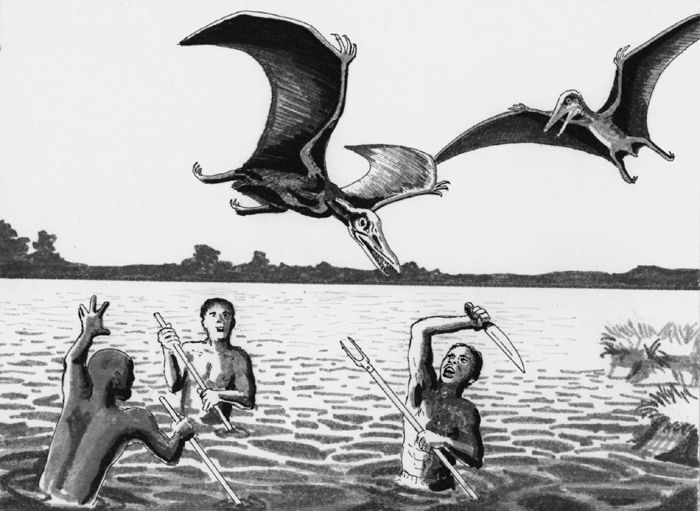 The Kongamato ("breaker of boats") is a reported pterosaur-like creature from the border area of Zambia, Angola and Congo. Suggested identities include a modern-day Rhamphorhynchus, a misidentified bird (such as the very large and peculiar Saddle-billed Stork), or a giant bat.
The Kongamato ("breaker of boats") is a reported pterosaur-like creature from the border area of Zambia, Angola and Congo. Suggested identities include a modern-day Rhamphorhynchus, a misidentified bird (such as the very large and peculiar Saddle-billed Stork), or a giant bat.Frank Melland, in his 1923 book In Witchbound Africa, describes it as living along certain rivers, and very dangerous, often attacking small boats. It was red, with a wingspan of 4 to 7 feet. Members of the local Kaonde tribe identified it as a pterodactyl after being shown a picture of one from Melland's book collection.
In 1956 an engineer, J.P.F. Brown, allegedly saw the creature at Fort Rosebery near Lake Bangweulu in Northern Rhodesia (now Zambia). It was about 6:00 p.m. when he saw two creatures flying slowly and silently directly overhead. He observed that they looked prehistoric. He estimated a wingspan of about 3 to 3 1/2 feet (1 meter) and a beak-to-tail length of about 4 1/2 feet (1.5 meters). It reportedly had a long thin tail, and a narrow head which he likened to an elongated snout of a dog.
Some 65 million years ago, starting in the Jurassic and lasting into the Cretaceous, there existed a powerful flying reptile known as the Pterosaurs. The majority of fossils found have been in marine deposits, which means they probably were fish eaters and spent most of their time over coastal waters. These Pterosaurs apparently managed to fly with no feathers, their main aerodynamic feature where wings of membrane supported by an enormously elongated fourth finger. They had hollow limb bones and a large keeled breastbone attached to strong wing muscles which where needed for true flight, not just gliding.
The large expenditure of energy required to remain in flight for long periods of time, and the resulting loss of heat caused by the surface of their wings exposed to moving air, means that they must have had some method of regulating body heat, although it is doubtful they were truly warm blooded as mammals are. The majority of the Pterosaurs species where anywhere from the size of a sparrow to the size of an eagle, however some larger species have been discovered. The Pteranodon with a wingspan of 27 ft. and the colossal Quetzalcoatlus, with a wingspan of 50 ft, possibly 60 ft. are two examples of these larger species. Some pterosaurs even had fur, although they are in now way related to mammals. It would seem impossible that these creatures could have survived to the present day. After all, if they existed surely people would see them flying about as they hunted for food. How could a flying population of reptiles remain hidden? There are reports that people have been seeing flying creatures that match the description of pterosaurs for a hundreds of years. People have even been reportedly killed by these ancient flying creatures.
Read more at http://theunexplainedmysteries.com/Kongamato.html

No comments:
Post a Comment